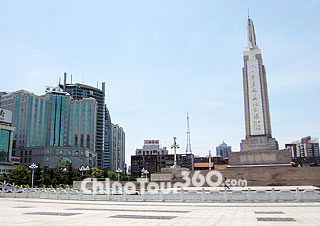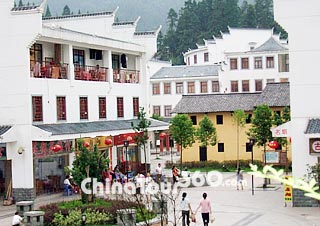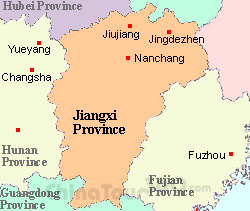 Nanchang City
Nanchang City Unique Constructions in Mt. Jinggang
Unique Constructions in Mt. Jinggang Mt. Jinggang
Mt. Jinggang
![]() Facts
Facts
Phone Code: 0791
Postal Code: 330000
Area: 7,402 Sq km (2,858 Sq miles)
Population: 5,052,500 (in 2010)
Nationalities: Han, Manchu, Hui, Zhuang
Neighboring Areas: Zhejiang, Fujian, Guangdong, Hunan, Hubei, and Anhui Provinces
Location: Nanchang is located in the central-north of Jiangxi Province, on the lower reaches of the Ganjiang River and Fuhe River, and bordering Poyang Lake.
![]() Physical Features: Located predominantly on a plain, Nanchang's topgraphy is generally flat in the southeast and hilly in the northwest. The average altitude is only 25 m (82 feet), with the highest point, at Meiling Main Peak of Xishan Mountain, just 841.4 m (2760.5 feet) above sea level. The landscape is densely covered by rivers and lakes that take up 29.8% of the total area.
Physical Features: Located predominantly on a plain, Nanchang's topgraphy is generally flat in the southeast and hilly in the northwest. The average altitude is only 25 m (82 feet), with the highest point, at Meiling Main Peak of Xishan Mountain, just 841.4 m (2760.5 feet) above sea level. The landscape is densely covered by rivers and lakes that take up 29.8% of the total area.
 |
| Nanchang Maps |
![]() History: In 202 BC, Emperor Liu Bang of the Han Dynasty (206 BC - 220) sent his army into Nanchang, building the original city and giving it the name Nanchang. It was also established as the administrative center of Yuzhang Commandery. After, in the Sui Dynasty (581 - 618), it became part of Hongzhou Prefecture. Thereafter, it was always the provincial center of Jiangxi Province, although the named changed several times. During the period of Republic of China, it was, for a time, the military center for Chiang Kai-shek. It was also a base where the revolutionary flag was first raised.
History: In 202 BC, Emperor Liu Bang of the Han Dynasty (206 BC - 220) sent his army into Nanchang, building the original city and giving it the name Nanchang. It was also established as the administrative center of Yuzhang Commandery. After, in the Sui Dynasty (581 - 618), it became part of Hongzhou Prefecture. Thereafter, it was always the provincial center of Jiangxi Province, although the named changed several times. During the period of Republic of China, it was, for a time, the military center for Chiang Kai-shek. It was also a base where the revolutionary flag was first raised.
![]() Attractions: Crisscrossed by rivers and lakes such as Ganjiang River, Aixi Lake and Poyang Lake, the city possesses beautiful water scenery. Meiling Mountain, famed as a 'Small Lushan', is a national forest park, and represents the mountain sights of the city. Tengwang Pavilion (one of the 'Three Well-known Pavilions South of the Yangtze River’) and Badashanren Memorial Hall add additional historical and cultural elements to the city. As a revolutionary base, it also has numerous revolutionary sites such as the August 1st Uprising Memorial Hall, Nanchang August 1st Uprising Memorial Tower and the Memorial of Comrade Zhu De's Former Residence.
Attractions: Crisscrossed by rivers and lakes such as Ganjiang River, Aixi Lake and Poyang Lake, the city possesses beautiful water scenery. Meiling Mountain, famed as a 'Small Lushan', is a national forest park, and represents the mountain sights of the city. Tengwang Pavilion (one of the 'Three Well-known Pavilions South of the Yangtze River’) and Badashanren Memorial Hall add additional historical and cultural elements to the city. As a revolutionary base, it also has numerous revolutionary sites such as the August 1st Uprising Memorial Hall, Nanchang August 1st Uprising Memorial Tower and the Memorial of Comrade Zhu De's Former Residence.
![]() Transportation: Located centrally between the Yangtze and Pearl River Delta regions, the city serves as a major railroad hub in South China.
Transportation: Located centrally between the Yangtze and Pearl River Delta regions, the city serves as a major railroad hub in South China.
![]() Air: Nanchang Changbei Airport has around 35 air routes to major Chinese cities, including Beijing, Fuzhou, Guangzhou, Xian, Shanghai and Hong Kong, operating on average nearly 100 flights per week.
Air: Nanchang Changbei Airport has around 35 air routes to major Chinese cities, including Beijing, Fuzhou, Guangzhou, Xian, Shanghai and Hong Kong, operating on average nearly 100 flights per week.
![]() Train: Nanchang Railway station is an important station on the Beijing-Kowloon Railway and the Zhe-Gan Railway. The station operates over 60 pairs of departure or transit trains to large and medium cities in China such as Beijing, Shanghai, Guangzhou, Shenzhen and Xian.
Train: Nanchang Railway station is an important station on the Beijing-Kowloon Railway and the Zhe-Gan Railway. The station operates over 60 pairs of departure or transit trains to large and medium cities in China such as Beijing, Shanghai, Guangzhou, Shenzhen and Xian.
![]() Ferry: Nanchang Port, as the largest port along the Gangjiang River, operates ferries to Boyang, Duchang, Ruihong, Zhouxi and Lianhu. In recent years, water transport out of the city has been often out of service during the low-flow period, influenced by the climate and other factors.
Ferry: Nanchang Port, as the largest port along the Gangjiang River, operates ferries to Boyang, Duchang, Ruihong, Zhouxi and Lianhu. In recent years, water transport out of the city has been often out of service during the low-flow period, influenced by the climate and other factors.
![]() Bus: There are three major long-distance bus stations in the city - Nanchang Long-distance Bus Station, Changnan Bus Station and Xufang Bus Station. Buses from these stations connect it with dozens of cities outside Jiangxi Province and all of the towns, counties and cities within Jiangxi. City buses in the city cover all of the trunk ways and well-known tourist attractions. Several special, regular and tourism lines have also been opened for the convenience of the visitors. These include Bus No. 7, 18, 16 and 26 to Tengwang Pavilion and Bus No. 219 to Meiling Mountain.
Bus: There are three major long-distance bus stations in the city - Nanchang Long-distance Bus Station, Changnan Bus Station and Xufang Bus Station. Buses from these stations connect it with dozens of cities outside Jiangxi Province and all of the towns, counties and cities within Jiangxi. City buses in the city cover all of the trunk ways and well-known tourist attractions. Several special, regular and tourism lines have also been opened for the convenience of the visitors. These include Bus No. 7, 18, 16 and 26 to Tengwang Pavilion and Bus No. 219 to Meiling Mountain.
![]() Taxi: The city is not big, so taxi should be the most convenient means of transport. The flag-fall of the taxis is CNY6 and the rate is CNY1.9 per km for distances exceeding 2 km (1.2 miles).
Taxi: The city is not big, so taxi should be the most convenient means of transport. The flag-fall of the taxis is CNY6 and the rate is CNY1.9 per km for distances exceeding 2 km (1.2 miles).
![]() Weather: Nanchang is a typical city where it is very hot in summer and extremely cold in winter, so spring and autumn are, of course, the best time to visit.
Weather: Nanchang is a typical city where it is very hot in summer and extremely cold in winter, so spring and autumn are, of course, the best time to visit.
![]() Dining and Shopping
Dining and Shopping
Characterized by their heat, crispness, tenderness and softness, Nanchang dishes are mostly oily and delicious with distinctive colors. Popular dishes are Kuanglu Stone Chicken Legs, Poyang Lake Lion-Head Meatballs, Braised Turtle and Wuyuan Longfeng Glutinous Rice Balls. Local snacks include Home-style Rice Crust, Mala Tang and Nanchang Rice Noodles. Restaurants are mainly located on Ruzi Road, Fuzhou Road, Er’qi Road and Yanjiang Road.
In addition to the local specialties like Lidu Kaoliang liquor, Anyi loquats and Poyang Lake silverfish, there are a number of handicrafts popular among the visitors. These include Nanchang porcelain portraits and Jiangxi paper fans. Shopping areas are the Nanchang Department Store and the Pacific Shopping Center on Zhongshan Road, Hongcheng Building on Beijing Road and the agricultural products wholesale market on Jinggangshan Avenue. There are also several characteristic shopping streets such as the Tourism Street on Fuzhou Road, the Tea Art Street on Minde Road, the Food Street on Ruzi Road and the Clothing Street on Guangchang North Road.







